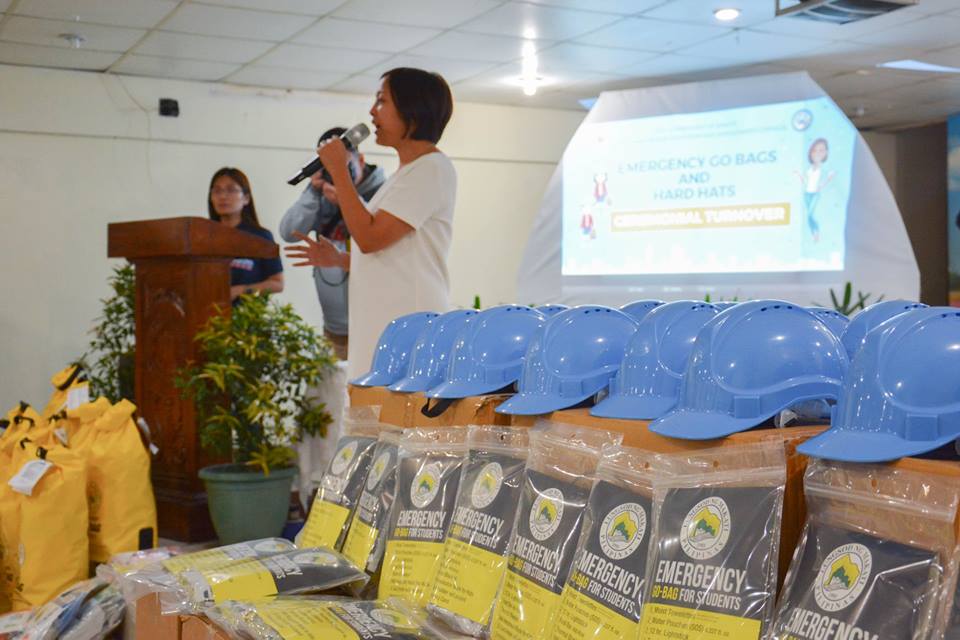News
Binay provides 12,298 ’emergency go bags’ to Makati public schools

Several public schools in Makati City have received a total of 12,298 Emergency Go Bags on Monday as part of the city government’s disaster preparedness program. (Photo: My Makati/Facebook)
MANILA — Several public schools in Makati City have received a total of 12,298 Emergency Go Bags on Monday as part of the city government’s disaster preparedness program.
Mayor Abby Binay led the distribution which was done consecutively in Maximo Estrella Elementary School, Pio del Pilar Elementary School, Benigno “Ninoy” S. Aquino High School, and Fort Bonifacio Elementary School.
Binay said the Emergency Go Bag Project is part of intensified efforts to prepare communities for disasters and other emergency situations.
“We are giving priority to building disaster readiness in our schools because these are where children, who are among our most vulnerable constituents, stay for the most part of the day,” the lady mayor said.
A “go bag” is a portable survival kit recommended by emergency response experts for every household or facility. It is meant to help an individual or a family survive, at least in the next 72 hours after a disaster, and contains essential needs such as food and drinking water, hygiene kit, first aid kit, flashlight, and other handy materials.
Binay said for the initial rollout of the project to all public day care, preschool, elementary and secondary schools in the city, the city government will release 1,600 Emergency Go Bags; 10,698 Individually-packed Go Bags; 17,300 small helmets for children; and 8,775 adult helmets for teachers and school personnel.
Binay expressed her resolve to promote a higher level of readiness among Makatizens through building their individual capability for survival.
“I envision a city where people can cope well on their own during and immediately after a disaster, instead of passively waiting for emergency response teams to arrive,” she underscored.
Based on the mayor’s directive to empower communities through proper information and training and adequate tools to survive calamities, the Makati Disaster Risk Reduction and Management Office (MDRRMO) has prioritized the full implementation of the said project this year.
MDRRMO chief Richard Raymund Rodriguez said two types of Emergency Go Bags following international DRRM standards have been assembled by his team.
Emergency Go Bag 1 contains a total of 91 items which include a hygiene kit and various tools for light and communication, first aid, and protection, as well as emergency tools. Among the bag’s contents are an emergency rope, 13-function folding pocket knife, thermal blanket, tube tent, and a hand crank radio with flashlight.
Emergency Go Bag 2, which is an individually-packed emergency kit, has 14 items including food bars, emergency stick (glow-in-the-dark), thermal blanket and N95 respiratory mask for kids.
Rodriguez said all Emergency Go Bags will be stored in the classrooms of the target schools, with one Go Bag 1 allocated for each classroom. For Go Bag 2, he said certain quantities have been allocated per school initially, but that the end-goal is to provide them on a 1:1 ratio or one bag per student before 2018 ends.
Aside from the distribution of emergency bags in each school, the city government through MDRRMO is also rolling out infomercials for children, highlighting the value of preparing personal emergency bags at home, and teaching and citing examples on what to do and what to pack to prepare for disasters.
Meanwhile, the Makati DRRM Academy, launched recently at the University of Makati, opens an avenue for ordinary citizens to become certified DRRM practitioners.
Recently, Mayor Binay presented Makati City’s formula for disaster preparedness and resilience at an international workshop on disaster resilience jointly hosted by the University of Huddersfield, United Kingdom and the De La Salle University, Manila. The mayor shared lessons learned and benefits gained by the city in adopting the “Making Cities Resilient Tools” under the United Nations International Strategy for Disaster Reduction (UNISDR).
UNISDR has certified Makati City as a “Campaign Champion for Making Cities Resilient” and “Role Model City”, while the World Bank has named the city one of “East Asia’s Climate Resilient Cities”.





















